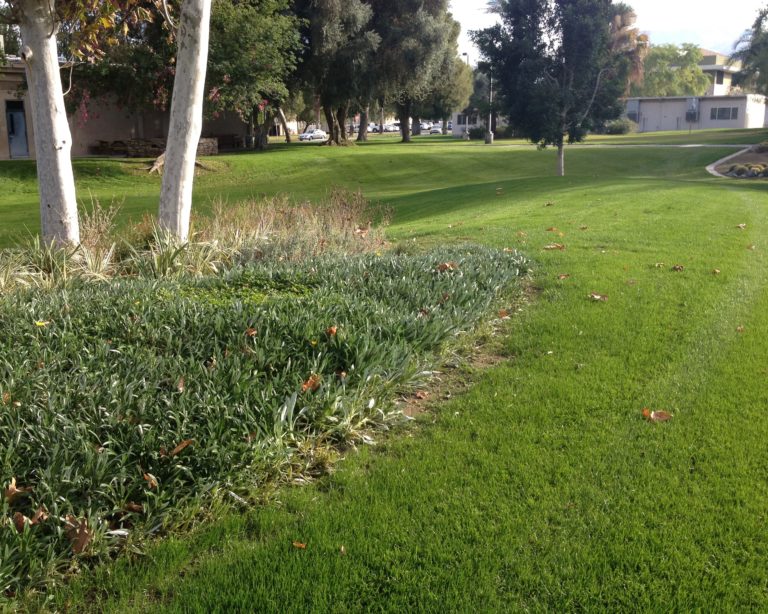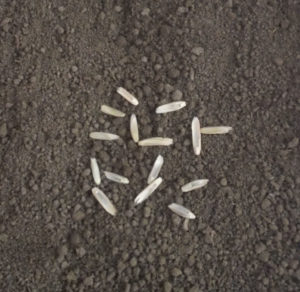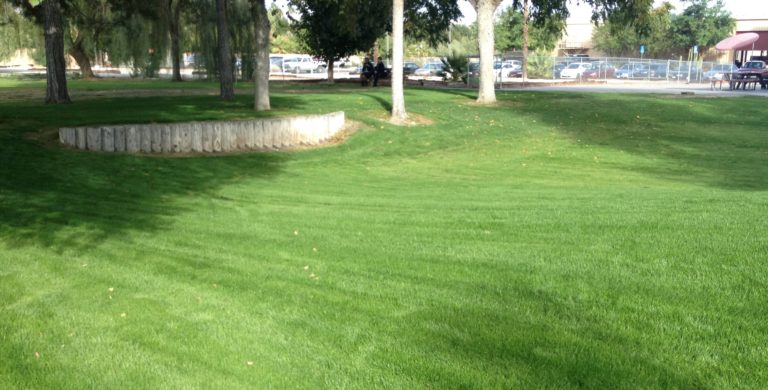Rethinking Winter Overseeding
Many who care for warm-season turf look upon winter overseeding with a certain amount of apprehension, perhaps thinking the practice a necessary evil. Northern-dwelling snowbirds flee their colorless environments back home with visions of a picture-perfect green oasis in their heads. They rarely consider the hard work involved in making those dreams a reality prior to their arrival.
Demand for year-round green is here to stay, therefore so is winter over-seeding. Fortunately, this process has advanced considerably in the last decade with faster germination rates, increased tolerance for saline environments, and transition timing dialed in to occur precisely with the return of warm weather. There are several cool-season ryegrass varieties to choose from to meet the needs of every environment where over-seeding is practiced. Overseeding methods have also become more sophisticated, efficient, and effective than ever. Today, preparation and timing the seasonal weather change are the biggest challenges. So how can you be ready when the time comes?
Being Prepared Creates its Own Opportunities.
Hopefully, we can provide some guidance in preparing for the transition. There is more to winter over-seeding than the color. When bermudagrass goes dormant, it becomes more vulnerable to traffic and wear. As the roots draw upward and the leaves dry out, it doesn’t take much to kill the plants outright. Come spring, as the bermudagrass starts to green up again, you may find your turf area riddled with patches and stripes of damaged turf, even uglier to the eye than a sea of yellow grass. A winter bed of ryegrass can absorb the wear and tear of winter activities and protect the fragile bermudagrass underneath. This can reduce the chances of long-term damage to your turf, however, wear and tear isn’t the only predator out to kill your bermudagrass. The winter temperatures can take a heavy toll on your bermudagrass turf. Cool-season grasses, such as ryegrass, tolerate occasional frost with much greater resilience and in general, provide a layer of protection from the elements. So, any damage your winter Ryegrass sustains will be gone forever with the return of spring, leaving behind a healthier crop of summer Bermudagrass.
Overcoming Challenges: Managing Growth and Invasives
An insidious problem with overseeding is that it may retard the growth of your bermudagrass in the spring. Ryegrass that proves a bit too robust may wear out its welcome when bermudagrass is ready to revive, choking it until there’s nothing left when the ryegrass finally dies. Traditionally, chemical treatments along with proper mowing and maintenance, have ushered out the ryegrasses at the proper time. Today new varieties, bred specifically for over-seeding, are reducing the need for expensive treatments. The right variety of ryegrass, like Barbados perennial ryegrass, transitions out largely by itself just as temperatures rise to a bermudagrass-friendly level.

Today New Varieties, Bred Specifically for Over-Seeding, are Reducing the Need for Expensive Treatments.
In the Southwest, where water supplies are limited, the use of effluent water has become increasingly common. This coupled with saline environments has been a major obstacle to successful over-seeding in the past. This problem has been alleviated by new cultivars like Fiji II perennial ryegrass with its improved salt tolerance at the establishment and growing stage. Other varieties that work exceedingly well for over-seeding are Belize, Oahu, and Perennial Ryegrass.
Another well-known over-seeding concern is annual bluegrass (poa annua). It often finds its way into lower-priced ryegrass blends and creeps in on its own during the cold months. If your bermudagrass is severely thinned by vertical mowing, and your winter ryegrass is slow to establish, poa-annua can invade and spread quickly. Fortunately, this offensive plant can be controlled (albeit not altogether eliminated) through sound cultural practices. When high-quality ryegrasses are properly applied they will maintain dominance, preventing poa annua from getting a firm grip on your turf. Pre-emergent herbicides can certainly come to the rescue if need be, but the better solution is to employ an over-seeding variety, such as the ones previously mentioned, which germinate quickly and hold the ground until spring.
The weather may be with you or against you, the bermudagrass may be too quick to sleep or too slow to revive, and who knows what else may interfere? The best defense is a good offense, as they say. Use the best seed available, adopt rigorous overseeding practices that are right for your turf and its environment, and be on ready to react to conditions as they change. Being prepared creates its own opportunities.
Before you begin overseeding, be sure your equipment is in good repair. Since timing is a factor in a smooth transition, delays due to improperly maintained equipment can be costly in both time and money. You may need to sharpen the mower blades frequently to maintain the quality of the cut. Check your irrigation system to make sure that each head is working properly. This ensures uniform coverage of the turf. Preparation of the seedbed is as important to the success of over-seeding as it is to the establishment of new turf. In fact, poor seedbed preparation is one of the most common causes of a poor over-seeding experience. Seedling diseases and thin stands of grass are the result of excess thatch, compacted soils, and weeds in the seedbed. All of which can be avoided through proper maintenance and preparation.
Executing the Over-Seeding Process with Precision
Fortunately, many year-round maintenance practices can help keep your turf in good shape for over-seeding. Begin with light vertical mowing in late summer to reduce the thatch in your bermudagrass. Continue this practice into the fall, while the growth of the bermudagrass slows. Aeration and topdressing, both in late spring and late summer, reduce thatch and help prepare the seedbed while improving the turf surface. However, do not aerate after September 1, as it promotes the germination of poa-annua. Reduce your nitrogen levels about four-to-six weeks before you begin your over-seeding program. Instead, use fertilizers high in phosphorus and potassium. This will decrease the bermudagrass’ ability to compete with the newly emerging winter turf, and it will help it brace for the coming winter weather by forcing it to store essential carbohydrates. The above guidelines should be sufficient to prepare your turf for winter over-seeding. However, depending on your local climate, it may be necessary to apply a broad-spectrum fungicide a week or two before you begin. This will reduce soil-borne organisms that attack your seedling ryegrasses.

Proper Seedbed Preparation is the Key to Success with any Over-Seeding Ryegrass Variety. Timing is a Close Second.
There are two techniques available to force Bermudagrass into dormancy. The first is to deprive it of water, then scalp it. Reduce your watering schedule by half for a week, and then stop watering altogether. Don’t forget to take care of your trees, shrubs, and other landscaping elements though! Within a week to 10 days, you’ll be ready to begin the mechanical operations of scalping: Mow the grass to a height of 3/8 to 1/2 inch. Use flextime harrows or a steel rake to stand the grass back up for additional scalping if needed. Repeat this procedure two-to-four times until the bermudagrass has been sufficiently thinned allowing your ryegrass seed to reach the soil easily. About 50% of the surface should be laid bare. The debris generated by this procedure should be collected and hauled away. The removal process is a very important step.
The second technique for nudging your bermudagrass into dormancy involves the use of chemical growth retardants. This method requires keeping the bermudagrass actively growing for a week to 10 days before applying the retardant. This allows the turf to readily absorb it. Once applied, immediately shut off the water. This will prevent the bermudagrass from re-growing for about 30 days and give the ryegrass an opportunity to establish.
Proper seedbed preparation is the key to success with any over-seeding ryegrass variety. Timing is a close second. Your seed dealer should have tables suggesting ideal over-seeding dates for your area, but the most reliable gauge is the temperature of the soil. According to the research conducted by leading seed breeders, the optimum time is when the soil temperature ranges between 72 and 78 degrees (F.), at a 4-inch depth. Typically, the air temperatures will be 80 to 85 degrees by day and 60 degrees by night when the soil is ready. One or two degrees too warm or too cold can make a one-to-two-week difference in establishment timing so watch closely. Once you’ve identified the typical time these soil temperatures occur, plan to plant your seed. Remember, soil temperature is a critical factor.
Uniform seed distribution is essential to establishing a healthy stand of winter turf. During the seeding process, periodically check your seed bin to ensure proper seed distribution as not all varieties are of similar size or purities. Accurately calibrating your spreader and distributing the seed from several directions ensures uniform distribution. To keep from spreading seeds to unwanted areas, carpets and mats may be placed along the edges of the seeding areas for nice clean lines. Once you have spread your seed, lightly top-dress with sand or a topdressing mixture. Next, smooth into the turf by dragging a brush or carpet in a zigzag or shifting oval pattern. This process moves the seed into place for vigorous germination and allows the use of the turf while the ryegrass is established. Use about 1/3- to 1/2 cubic feet of sand per 100 square feet. Topdressing immediately after seeding can result in four to five times more turf cover in the first four weeks! Follow immediately with thorough watering, taking care not to create standing water or water-soaked areas as this may make them prone to disease. Continue with frequent light watering while the seed is established, and follow recommended schedules for establishment and usage throughout the winter. Light watering two or three times each day, for 7-10 days, should deliver the desired results.
Seeding Rates Seeding rates can vary widely depending on variety and desired results. Here are common standards often used by golf courses:
- Fairways: 400 to 600 pounds per acre,
- Roughs: 300 to 400 pounds per acre,
- Tees: 35 pounds per 1,000 square feet,
- Greens: 25 pounds per 1,000 square feet.

Demand for Year-Round Green is Here to Stay.
The winter turf maintenance practices will be somewhat reversed for the spring transition when warm weather returns and the bermudagrass is ready to make its comeback. As with winter over-seeding, soil temperatures are the key to a smooth transition. Bermudagrass resumes growth when the soil reaches a temperature of 60-to-64 degrees at a depth of 4 inches, so monitor your soil and plan accordingly. When this occurs begin by grooming or lightly verti-cutting once or twice per week and gradually reduce the height of your cut. This reduces shading and helps to warm the soil, preparing the winter turf for its final exit. If the weather is cool, spike the turf every two weeks. Aerify and pulverize the plugs several weeks before you expect the bermudagrass to begin its green-up, which also helps to warm the soil. Continue with normal spring and summer aerification practices going forward from here. Delay spring fertilization until 2-3 weeks after spring green-up. At that point, resume normal recommended levels and increase the Nitrogen component. It is sometimes necessary to apply high rates of ammonium nitrate to burn down the ryegrass and speed its transition. Maintaining good soil moisture levels encourages the bermudagrass to re-establish its root system.
By observing these steps, and with a little help from Mother Nature, you’ll have your summer turf back in short order. Now you can begin to plan for next fall’s overseeding program!
For a printable, PDF version of this blog, click below.
The Need to Overseed. PDF


